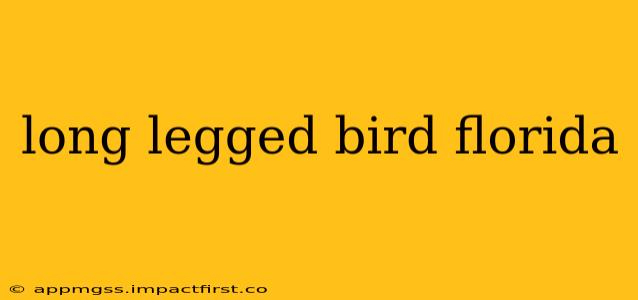Florida's diverse ecosystems, from coastal marshes to pine flatwoods, support a wide variety of bird species. Many of these are easily recognizable by their long legs, which are crucial for wading in shallow water, stalking prey, or traversing various terrains. This guide explores some of the most common long-legged birds found in the Sunshine State, addressing frequently asked questions about their identification and behavior.
What are some common long-legged birds in Florida?
Several bird species in Florida boast impressively long legs. Some of the most common include:
-
Wading Birds: These birds are masters of wetland habitats. Examples include Great Blue Herons (easily identified by their size and blue-gray plumage), Great Egrets (large, completely white with a yellow bill), Snowy Egrets (smaller, white with black legs and a black bill during breeding season), Little Blue Herons (small, slate-blue birds), White Ibis (distinctive curved bill), Wood Storks (large, bald head, and neck), and various species of herons and egrets.
-
Shorebirds: These birds frequent coastal areas, beaches, and mudflats. Look for birds like Sanderlings (small, constantly running along the shoreline), Willets (large, with long, slightly upturned bills), and various plovers and sandpipers. These birds often have proportionately long legs relative to their body size.
-
Other Long-Legged Birds: Don't forget about birds like cranes (if you're lucky enough to spot a Sandhill Crane), long-legged raptors like the Limpkin (a brown bird with a long, down-curved bill), and even some species of rails that utilize their long legs for navigating dense vegetation.
What is the biggest long-legged bird in Florida?
The Wood Stork is likely the largest long-legged bird commonly found in Florida. These impressive birds can reach heights of up to 4 feet and have a wingspan exceeding 6 feet. Their long legs are perfectly adapted for wading in shallow water, where they hunt for fish and other aquatic prey.
What are some long-legged birds that are white?
Several long-legged white birds call Florida home. The most prominent are the Great Egret and the Snowy Egret. While both are white, the Great Egret is significantly larger, and the Snowy Egret displays black legs and a black bill during breeding season, providing key distinguishing features. The White Ibis, with its distinctive curved bill, is another common white long-legged bird found in Florida's wetlands.
Where can I see long-legged birds in Florida?
The best places to spot long-legged birds in Florida depend on the species you're hoping to see. However, some excellent locations include:
- Everglades National Park: A haven for wading birds and other long-legged species.
- Corkscrew Swamp Sanctuary: Famous for its population of Wood Storks and other wetland birds.
- Various coastal areas: Beaches, estuaries, and mudflats offer opportunities to see shorebirds.
- State parks and wildlife refuges: Many state parks and wildlife refuges across Florida provide excellent birding opportunities.
How can I identify long-legged birds in Florida?
Identifying long-legged birds requires careful observation. Consider these factors:
- Size: Compare the bird's size to familiar objects or other birds.
- Color and plumage: Note the overall color, patterns, and any unique markings.
- Bill shape and size: The shape and size of the bill are often crucial for identification.
- Leg color: Leg color can vary by species and even by the breeding season.
- Habitat: The bird's habitat provides valuable clues.
- Behavior: Observe its foraging behavior and any other distinctive actions.
Using a good field guide or bird identification app can greatly assist in confirming your identification.
By combining careful observation with the information provided above, you can enhance your birdwatching experience and appreciate the diversity of long-legged birds inhabiting Florida's beautiful landscapes. Remember to always practice responsible birding and respect wildlife and their habitats.
